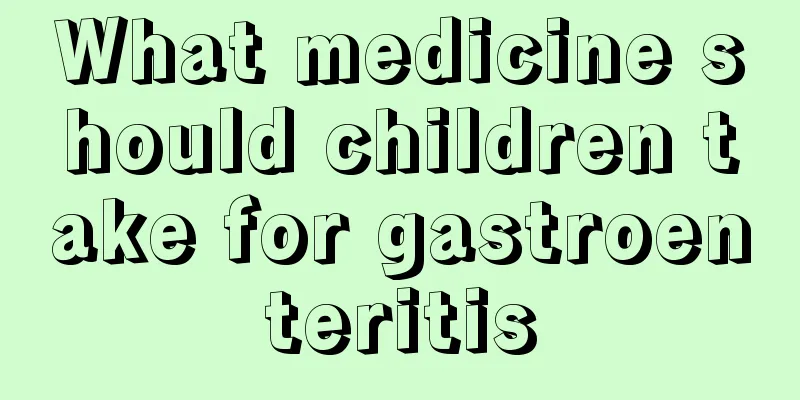What medicine should children take for gastroenteritis

|
The gastrointestinal development of infants and young children is not yet complete, and they are easily threatened by diseases, which often lead to symptoms such as abdominal pain, diarrhea, and indigestion. At this time, you can take some medicines suitable for children under the guidance of a doctor. The more common ones include Mommy Love, Weikang Granules, or Pi Ke Xin and other medicines. Of course, in addition to medication, you must strengthen your daily life and replenish water in time to prevent your child from dehydration. 1. Pay attention to fluid replacement and avoid dehydration Pay attention to dehydration symptoms: whether the child urinates less (the baby needs fewer diaper changes), cries without tears, has dry and inelastic skin, or has a sunken fontanelle. Regardless of whether the child has received an IV drip or not, you can buy electrolyte water specifically for diarrhea and give it to your child to drink as water. An IV may be necessary if a child's level of consciousness is decreased or if dehydration is severe. But oral rehydration therapy is still a good way to replenish fluids. Drinks high in simple sugars, such as soda, fruit juice, etc., are not recommended for children under 5 years old because they may worsen diarrhea. If there is no special oral rehydration solution or it tastes bad, plain water can also be used. If indicated, nasogastric tubes can also be used in children to supplement fluids. 2. Pay attention to diet and continue breastfeeding Formula-fed infants should continue formula feeding immediately after ORT rehydration. You can try brewing it with half milk (i.e. diluting the concentration by half) first. If the diarrhea condition does not improve within 3-7 days, you may need to switch to lactose-free milk powder (i.e. commercially available laxative milk powder) under the doctor's instructions. 3. Antiemetics Antiemetic medications may help treat vomiting in children, but they must be taken as directed by your doctor. Ondansetron has some utility, with a single dose reducing the need for intravenous fluids, hospitalization, and vomiting. However, the use of ondansetron may be associated with an increased risk of hospital readmission in children. If clinically necessary, ondansetron can also be administered orally in the intravenous form. Metoclopramide may be effective. 4. Antibiotics Antibiotics are not routinely used for gastroenteritis but may be recommended if symptoms are particularly severe or if a susceptible bacterium is identified or a bacterial infection is suspected. The World Health Organization (WHO) recommends that antibiotics be used for children who have both blood in their stools and a fever. 5. Antidiarrheal drugs Do not use antidiarrheal medicines in children—they may be dangerous. Antidiarrheal drugs have a theoretical risk of complications, although clinical experience suggests that this is unlikely, and are not recommended in cases of diarrhea with blood in the stool or fever. Loperamide is an opioid analog commonly used for the symptomatic treatment of diarrhea. However, loperamide is not suitable for use in children because the drug may cross the immature blood-brain barrier in children and cause toxicity. Children's gastroenteritis is much more complicated than adult gastroenteritis, so be sure to see a doctor. Indicators of hospitalization for gastroenteritis in children If a child has a persistent high fever for more than 48 hours, accompanied by vomiting, severe diarrhea, and more than 10 diarrhea episodes a day, he or she should be hospitalized. In addition, if diarrhea leads to severe dehydration (significant weight loss and decreased urine volume), coupled with lethargy and loss of appetite, and treatment with medication and electrolyte solutions is ineffective, hospitalization is also required. |
<<: Be careful of these signs of low IQ in your baby!
>>: What harm does fluorescent agent have on babies?
Recommend
Introduction to children's health care knowledge in autumn
As autumn approaches, the temperature difference ...
What are the symptoms of eight-month-old baby's eye mucus?
Eight-month-old babies can already crawl and have...
Is keratitis contagious in children?
Keratitis is a relatively common ophthalmic disea...
What are the traditional Chinese medicine treatments for hand, foot and mouth disease?
Many parents are very familiar with hand, foot an...
What is the reason for children's oliguria?
Once children have oliguria, timely treatment mus...
High lead level in baby
Family members cannot tell with the naked eye whe...
Children's common summer diseases "strategy"
Upper respiratory tract infection The rising temp...
What are the characteristics of children with ADHD?
Parents must observe their children's living ...
What is ringworm on baby's face?
Many babies have ringworm on their faces, which o...
How to treat white spot disease on children's face
We all know that children's skin is delicate ...
How to train children's memory
Only when the child's memory improves can the...
Blue on both sides of the child's nose
If a child's nose wings appear to be in heat,...
Can children eat crabs?
The deliciousness of crabs is irresistible to any...
What to do if children have poor physical fitness
Children need a lot of nutrients when they are gr...
What should I do if my child has cervical dislocation?
Children's bodies are still in the process of...









